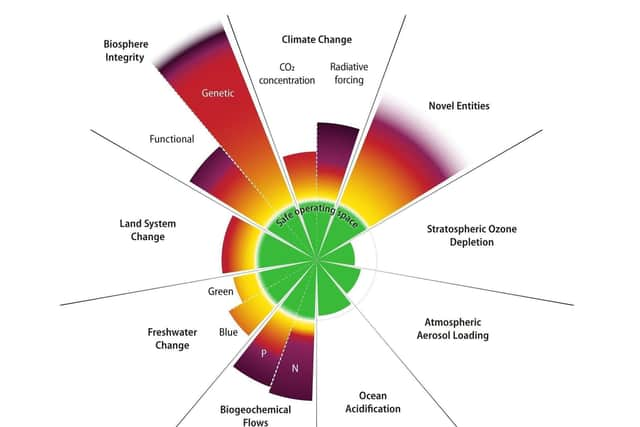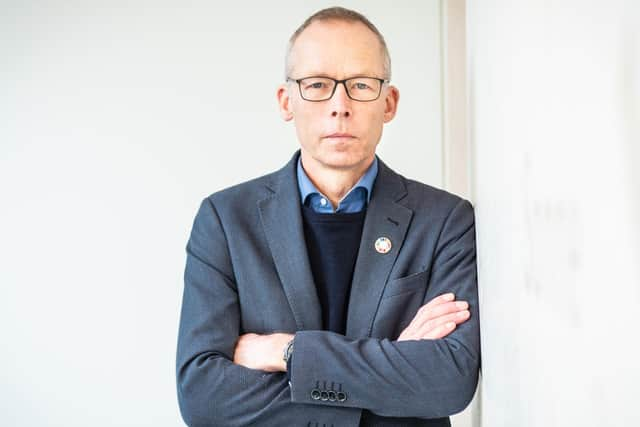Climate change: Everything you wanted to know about the end of the world but were afraid to ask – and how to stop it
Professor Johan Rockström is director of the Potsdam Institute for Climate Impact Research and professor at the Institute of Earth and Environmental Science at Potsdam University.
The Swedish academic also led development of the ground-breaking Planetary Boundaries Framework – a scale that defines the environmental limits within which humanity can safely operate.
Advertisement
Hide AdAdvertisement
Hide AdFirst published in 2009 but recently updated, the framework is represented as a pie chart divided into nine slices, or boundaries, which are crucial for healthy functioning of the earth’s systems.
The boundaries are: climate change; biosphere integrity; land-system change; freshwater use; biogeochemical flows (nitrogen and phosphorus); ocean acidification; atmospheric aerosol pollution; stratospheric ozone depletion; and release of novel chemicals (man-made compounds which do not exist in nature).
The chart is colour-coded to show the state of each system, graded from green in the centre – representing good health – changing to yellow, amber, then red and angry purple as the boundaries become stretched or go beyond their safe operating zone.
The bad news is the 2023 chart more closely resembles a burnt pizza than a verdant spinach pie.
Back in 2009, when the first iteration of the framework was published, not all of the nine boundaries had been quantified, but three were already in the danger zone. By 2015, four boundaries had been exceeded.


But the most recent update, completed this year, shows six of the nine boundaries have now been crossed, suggesting planet Earth is now well into unstable territory for human survival.
Of the three still in the green, ocean acidification is close to being breached, while aerosol loading regionally exceeds the boundary.
In an exclusive interview with the Scotsman, Prof Rockström explains why the framework is important.
Advertisement
Hide AdAdvertisement
Hide Ad“The nine planetary boundaries have been carefully scrutinised and investigated over 15 years now, and we scientifically conclude they are the nine systems that together determine the state of the planet,” he said.


“It’s not an arbitrary list of nine – it’s not like nine important environmental areas, it’s ‘The Nine’.
“It’s the nine that, as we understand it today, determine the life support or liveability for life and for humans and the world as we know it on planet earth. So if we can keep these nine in a good shape, then we have a good chance of also keeping the planet in a good shape in support of humanity.”
According to Prof Rockström, each boundary is important individually – with climate change considered the most critical – and exceeding any one can create instability. But the combination of multiple breaches reduces the planet’s ability to deal with the climate disturbance.
He says the latest research shows a grave situation.
“The assessment in 2023 is unfortunately that six of the nine are outside of the safe space,” he said.
“In 2015 we assessed that four of the nine were outside, and all of those four are now deeper into the red, so we continue moving in the wrong direction. More boundaries are outside of the safe space and those which were assessed to be outside seven years ago are even deeper into high-risk. So that’s a very worrying diagnostic.
“The planet is in bad shape and perhaps a very direct way of expressing that is that we focus rightly on the climate crisis, which is probably the most urgent global challenge that we have.
“But what worries us in planetary boundary research, we who study the whole planet, is that we are deep in the climate crisis, but at the same time we are losing the resilience of the planet, its capacity to deal with that disturbance.
Advertisement
Hide AdAdvertisement
Hide Ad“So when we are hitting the planet so hard with climate change or warming, causing an energy imbalance that stresses the ocean, ice sheets, and weather systems and all the eco-systems, you would wish the planet was in a very healthy state to be able to absorb that shock.
“But instead we are in the red on biodiversity, on freshwater, on land system change, on overloading of nitrogen and phosphorus, on air pollutants and on chemical loading. This means that you have a weakened planet when you need it to be stronger more than ever.
“This is what makes us particularly concerned.”
So are we at a point where we have pushed the globe so far adrift from stable conditions that we have crossed a planetary tipping point?
“We actually do not know yet,” Prof Rockström admits.
“The planetary boundary analyses show that we are at a high-risk point because six of the nine boundaries are outside of the safe space.
“That’s one of the big challenges ahead, to say – when do we reach a point where too many systems shift from dampening and cooling the planet to instead releasing greenhouse gases and self-amplifying warming? So that the planet would start drifting to what we call a hothouse earth state – meaning that even if we shut down all fossil fuel burning that it would just self-amplify towards more warming.
“We’re not there yet, but we have reasons to be worried.”
Despite the current situation, the professor said he believes we still have time to pull together, change life for the better and ensure the earth can remain liveable. He calls it Modernity 2.0.
And he will be attending the next United Nations climate summit, COP28, being held in Dubai next month, to push for action.
“We need to communicate the science much more widely across the world and to try to make people understand that we are now putting the stability of the entire planet at risk,” he said.
Advertisement
Hide AdAdvertisement
Hide Ad“Sustainability is today not a sacrifice, it’s a path towards a more healthy, prosperous, competitive, resilient and more equitable society. It’s not a threat to anyone. It’s a threat if we don’t do anything.
“The pathway to a sustainable future within planetary boundaries is a future we should be attracted by. Decarbonising the global energy system is doable today and it can give more jobs and better health and a more attractive outcome.
“That is the combination we need. We can tell the story of the risks but also of the opportunities of this transition.”
Rather than paradise lost, it can be paradise restored.
“We have positive messages to give, that’s the good news,” he said. “We know that a transition gives better outcomes.”
In conversation with Professor Johan Rockström, The 44th TB Macaulay Lecture, presented by the Macaulay Development Trust in partnership with the James Hutton Institute, is at 6pm on Wednesday, October 18, at McEwan Hall, University of Edinburgh. The event is free to attend, with seats available to reserve on Eventbrite, with a pre-lecture reception from 5pm for ticket-holders.
Comments
Want to join the conversation? Please or to comment on this article.